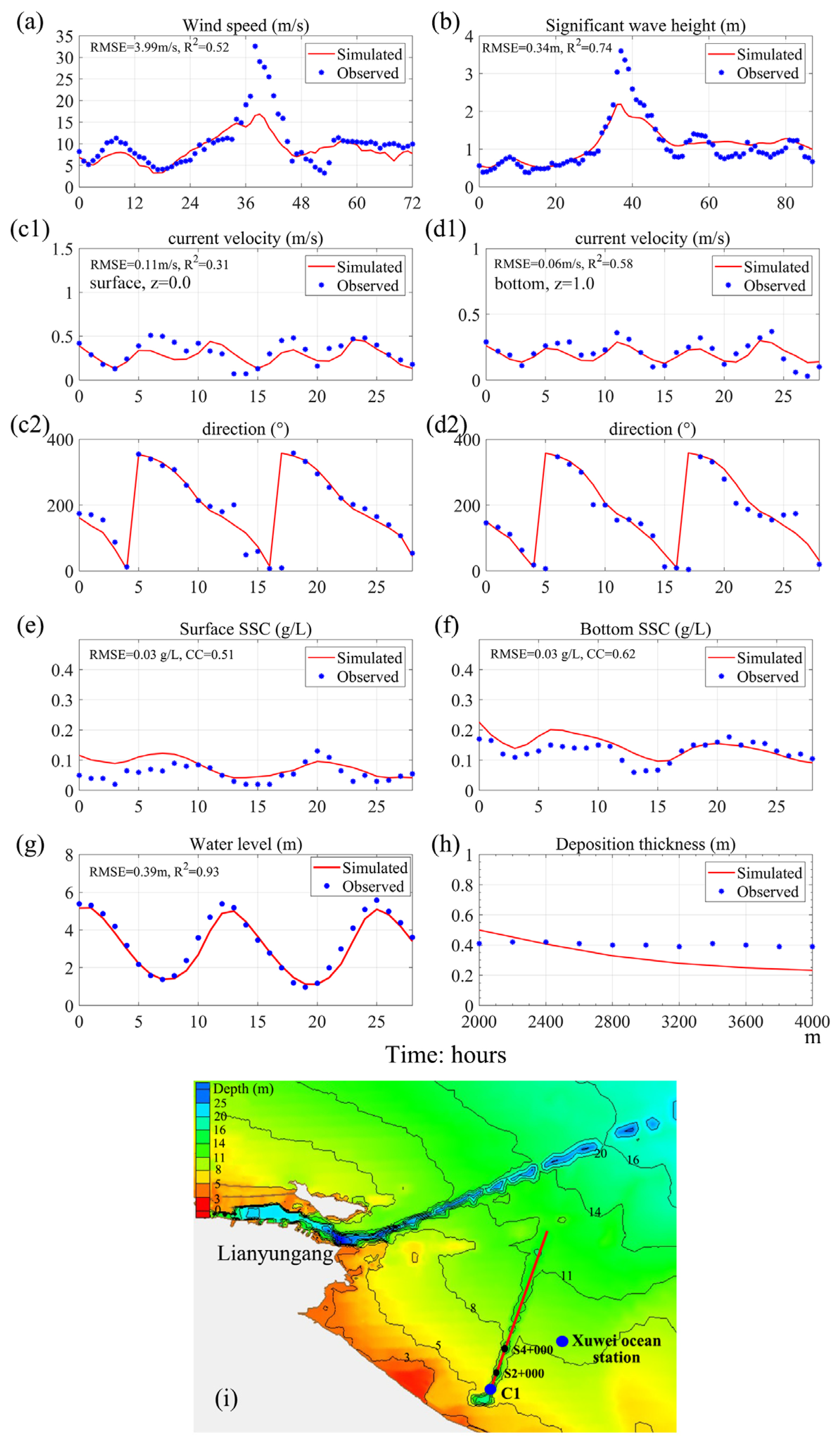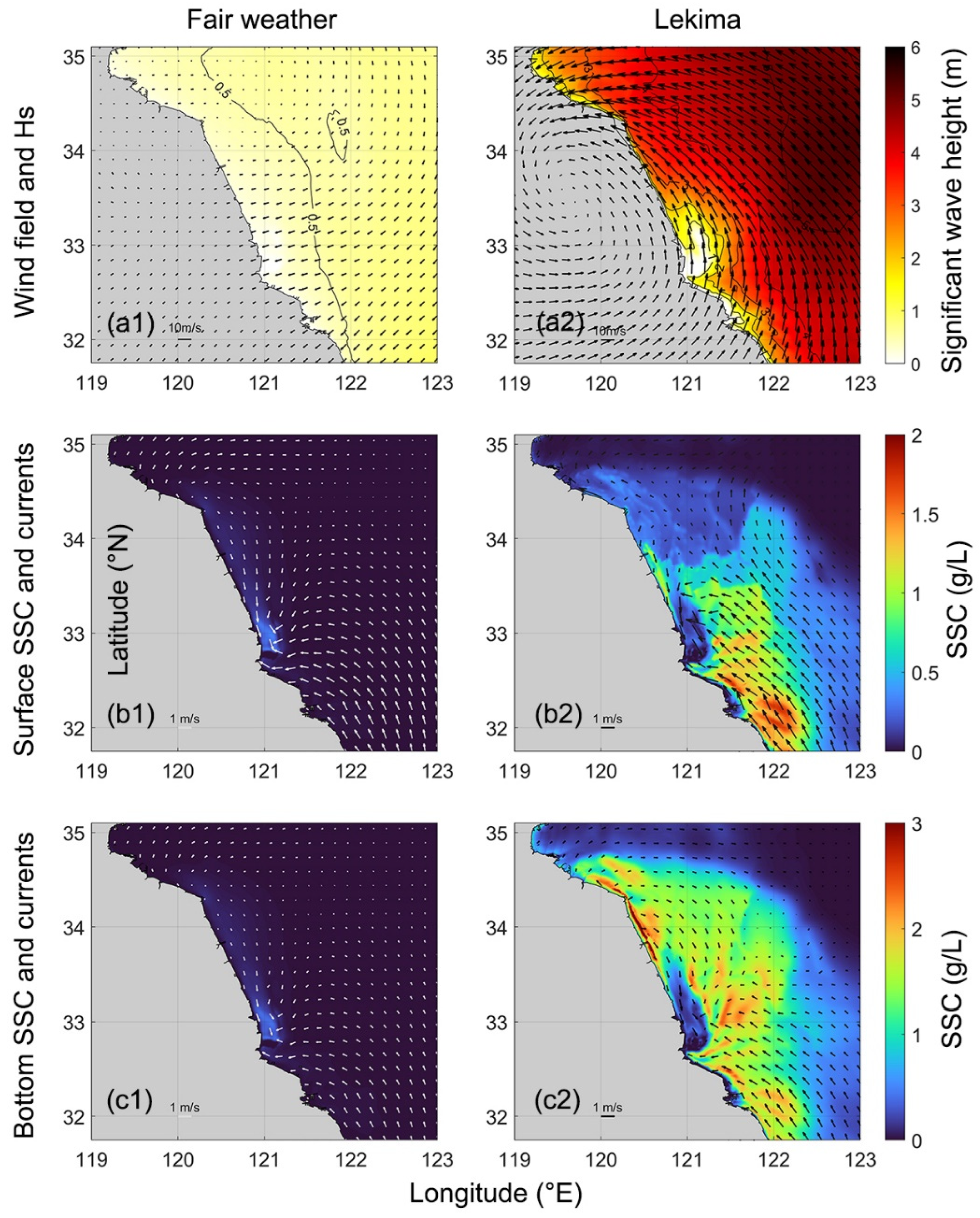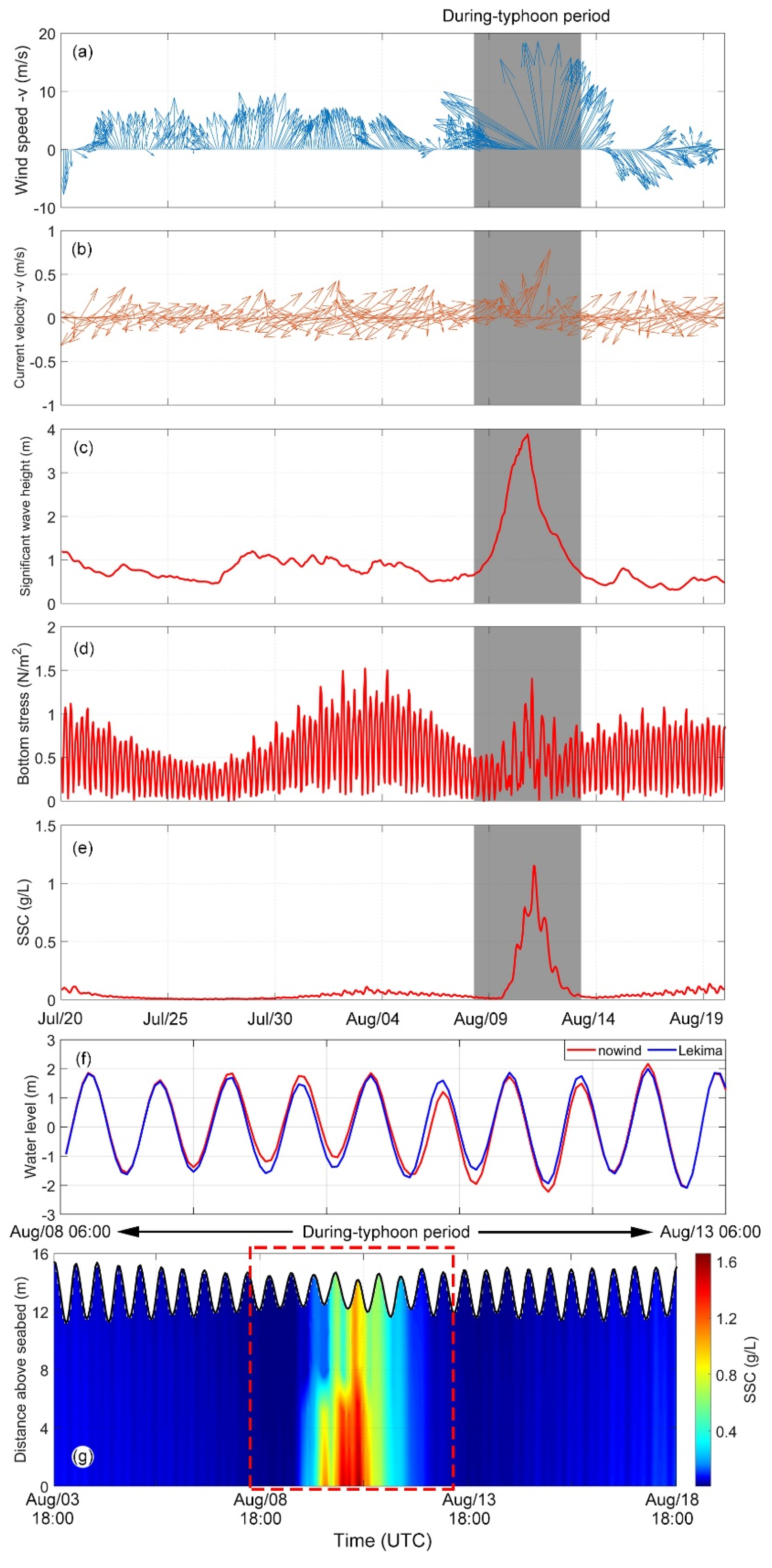Response of Sediment Dynamics to Tropical Cyclones under Various Scenarios in the Jiangsu Coast
Abstract
:1. Introduction
2. Regional Setting and Study Domain
3. Materials and Methods
3.1. Data Collection
3.2. Numerical Model
3.3. GOCI Satellite Remote Sensing Suspended Sediment Concentration (SSC) Retrieved Algorithm
3.4. Model Configuration
3.4.1. Model Setup and Initial Conditions
3.4.2. Numerical Experiment Settings
3.4.3. Model Validation
4. Results
4.1. The Response of Hydrodynamics and Sediment Dynamics to Typhoon Lekima
4.2. The Impact of TCs with Different Tracks and Intensities on Sediment Dynamics
5. Discussion
5.1. Example of a TC Affecting the JC during the Astronomical Tidal Period
5.2. Tidal Conditions during Different Typhoon Impact Periods
5.3. The Impact of Different Tidal Conditions on Sediment Dynamics during Typhoons
6. Conclusions
- (1)
- Typhoons significantly influence the hydrodynamics and sediment dynamics of the JC. During the passage of Typhoon Lekima (2019), under the influence of southeasterly winds exceeding 20 m/s, the current velocity, bottom stress, and significant wave height all increased significantly, with the SSC reaching nearly one hundred times that under fair-weather conditions.
- (2)
- Comparative analysis of four different typical-track typhoons showed that, under the influence of typhoons following three typical tracks and landing on the eastern coast of China, prevailing southeasterly winds brought a significant sediment flux from southeast to northwest along the JC, with a large magnitude. The typhoon that did not land and moved northward in the Yellow Sea brought a relatively smaller sediment flux from north to south. Additionally, typhoons caused intense stripe-like erosion and deposition in the sand ridges and deep channels, with maximum seabed thickness variations of up to ±0.3 m. The strengthening of the typhoon wind fields led to more significant sediment flux and morphological changes in the seabed.
- (3)
- During the impact of Typhoon Winnie within the spring tide cycle, its influence on sediment dynamics was greater than that of other landfall typhoons. Through numerical simulation experiments, it was found that if Typhoon Lekima affected the JC during spring tides, the net sediment flux within the tidal cycle could increase by 80% to 100% compared to the neap tide scenario. In the absence of tidal effects, the net sediment flux caused by the typhoon would be only 30–50% of that in the neap tide scenario. Furthermore, in the spring tide scenario, the impact of the typhoon on coastal geomorphological changes would be significantly greater than that under the neap tide or no-tide conditions.
Author Contributions
Funding
Institutional Review Board Statement
Informed Consent Statement
Data Availability Statement
Conflicts of Interest
Appendix A

References
- Yang, G.; Li, C.; Zhong, Y.; Pan, X.; Zhao, C.; Dong, C. Impact of tropical cyclones on the hydrodynamics and sediment dynamics of the radial sand ridge system in the southern Yellow Sea. Ocean. Model. 2024, 188, 102328. [Google Scholar] [CrossRef]
- Ma, X.; Wang, C.; Zhao, C.; Ji, M.; Zhu, J.; Yang, G.; Li, C. Identification and simulation the response of storm-induced coastal erosion in the China Yellow sea. Ocean. Eng. 2024, 300, 117394. [Google Scholar] [CrossRef]
- Trowbridge, J.; Nowell, A. Sediment Transport Events on Shelves and Slopes: STRESS; Pergamon: Oxford, UK, 1994. [Google Scholar]
- Green, M.O.; Vincent, C.E.; McCave, I.N.; Dickson, R.R.; Rees, J.M.; Pearsons, N.D. Storm sediment transport: Observations from the British North Sea shelf. Cont. Shelf Res. 1995, 15, 889–912. [Google Scholar] [CrossRef]
- Lu, J.; Jiang, J.; Li, A.; Ma, X. Impact of Typhoon Chan-hom on the marine environment and sediment dynamics on the inner shelf of the East China Sea: In-situ seafloor observations. Mar. Geol. 2018, 406, 72–83. [Google Scholar] [CrossRef]
- Emanuel, K. Increasing destructiveness of tropical cyclones over the past 30 years. Nature 2005, 436, 686–688. [Google Scholar] [CrossRef] [PubMed]
- Ren, M.-E.; Zhang, R.-S.; Yang, J.-H. Effect of typhoon no. 8114 on coastal morphology and sedimentation of Jiangsu Province, People’s Republic of China. J. Coast. Res. 1985, 1, 21–28. [Google Scholar]
- Pan, Z.-H.; Liu, H. Extreme storm surge induced coastal inundation in Yangtze Estuary regions. J. Hydrodyn. 2019, 31, 1127–1138. [Google Scholar] [CrossRef]
- Zhang, M.; Zhou, C.; Zhang, J.; Zhang, X.; Tang, Z. Numerical simulation and analysis of storm surges under different extreme weather event and typhoon experiments in the South Yellow Sea. J. Ocean. Univ. China 2022, 21, 1–14. [Google Scholar] [CrossRef]
- Cong, S.; Wu, X.; Ge, J.; Bi, N.; Li, Y.; Lu, J.; Wang, H. Impact of Typhoon Chan-hom on sediment dynamics and morphological changes on the East China Sea inner shelf. Mar. Geol. 2021, 440, 106578. [Google Scholar] [CrossRef]
- Xia, M.; Xu, F.; Wen, Y. Study of storm surge distribution along the Yangtze River and Estuary under different typhoon tracks. Ocean. Eng. 2022, 40, 115–122. [Google Scholar]
- Gong, Z.; Huang, S.; Xu, B.; Zhu, S.; Zhang, Y.; Zhou, Z. Evolution of tidal flat in response to storm surges: A case study from the central Jiangsu Coast. Adv. Water Sci. 2019, 30, 243–254. [Google Scholar]
- Ye, H.J.; Sui, Y.; Tang, D.L.; Afanasyev, Y.D. A subsurface chlorophyll a bloom induced by typhoon in the South China Sea. J. Mar. Syst. 2013, 128, 138–145. [Google Scholar] [CrossRef]
- Lapetina, A.; Sheng, Y.P. Simulating complex storm surge dynamics: Three-dimensionality, vegetation effect, and onshore sediment transport. J. Geophys. Res. Ocean. 2015, 120, 7363–7380. [Google Scholar] [CrossRef]
- Special Office in Jiangsu Province. General Report on Comprehensive Survey and Evaluation of Offshore Oceans in Jiangsu Province; Science Press: Beijing, China, 2012. [Google Scholar]
- Wang, X.H.; Qiao, F.; Lu, J.; Gong, F. The turbidity maxima of the northern Jiangsu shoal-water in the Yellow Sea, China. Estuar. Coast. Shelf Sci. 2011, 93, 202–211. [Google Scholar] [CrossRef]
- Xing, F.; Wang, Y.P.; Wang, H.V. Tidal hydrodynamics and fine-grained sediment transport on the radial sand ridge system in the southern Yellow Sea. Mar. Geol. 2012, 291, 192–210. [Google Scholar] [CrossRef]
- Xu, F.; Tao, J.; Zhou, Z.; Coco, G.; Zhang, C. Mechanisms underlying the regional morphological differences between the northern and southern radial sand ridges along the Jiangsu Coast, China. Mar. Geol. 2016, 371, 1–17. [Google Scholar] [CrossRef]
- Yu, Y.; Wang, Y.; Qiao, L.; Wang, N.; Li, G.; Tian, Z.; Zhong, Y. Geomorphological response of sandy beach to tropical cyclones with different characteristics. Front. Mar. Sci. 2022, 9, 1010523. [Google Scholar] [CrossRef]
- He, Y.; Chen, T.; Tang, J.; Chan, P.; Fu, J. Thermodynamic and Kinematic Structures in the Rainband Region of Typhoon Lekima (2019) at Landfall. Atmosphere 2022, 13, 312. [Google Scholar] [CrossRef]
- Zhang, J.; Xiong, M.; Zhang, W. Dataset for Reanalysis of Storm Surges and Waves during the Cold Wave Process and Typhoons in Northern Jiangsu from 1987 to 2019. 2021. Available online: https://english.casodc.com/data/metadata-special-detail?id=1462603128770781185 (accessed on 18 June 2024).
- Chen, C.; Liu, H.; Beardsley, R.C. An unstructured grid, finite-volume, three-dimensional, primitive equations ocean model: Application to coastal ocean and estuaries. J. Atmos. Ocean. Technol. 2003, 20, 159–186. [Google Scholar] [CrossRef]
- Mellor, G.L.; Yamada, T. Development of a turbulence closure model for geophysical fluid problems. Rev. Geophys. 1982, 20, 851–875. [Google Scholar] [CrossRef]
- Smagorinsky, J. General circulation experiments with the primitive equations: I. The basic experiment. Mon. Weather Rev. 1963, 91, 99–164. [Google Scholar] [CrossRef]
- Wu, L.; Chen, C.; Guo, P.; Shi, M.; Qi, J.; Ge, J. A FVCOM-based unstructured grid wave, current, sediment transport model, I. Model description and validation. J. Ocean. Univ. China 2011, 10, 1–8. [Google Scholar] [CrossRef]
- Yang, G.; Wang, X.H.; Zhong, Y.; Oliver, T.S.N. Modelling study on the sediment dynamics and the formation of the flood-tide delta near Cullendulla Beach in the Batemans Bay, Australia. Mar. Geol. 2022, 452, 106910. [Google Scholar] [CrossRef]
- Li, L.; Ren, Y.; Ye, T.; Wang, X.H.; Hu, J.; Xia, Y. Positive Feedback Between the Tidal Flat Variations and Sediment Dynamics: An Example Study in the Macro-Tidal Turbid Hangzhou Bay. J. Geophys. Res. Ocean. 2023, 128, e2022JC019414. [Google Scholar] [CrossRef]
- Li, L.; Wang, X.H.; Andutta, F.; Williams, D. Effects of mangroves and tidal flats on suspended-sediment dynamics: Observational and numerical study of Darwin Harbour, Australia. J. Geophys. Res. Ocean. 2014, 119, 5854–5873. [Google Scholar] [CrossRef]
- Booij, N.; Ris, R.C.; Holthuijsen, L.H. A third-generation wave model for coastal regions 1. Model description and validation. J. Geophys. Res. Atmos. 1999, 104, 7649–7666. [Google Scholar] [CrossRef]
- Yang, G.; Wang, X.H.; Zhong, Y.; Cheng, Z.; Andutta, F.P. Wave effects on sediment dynamics in a macro-tidal estuary: Darwin Harbour, Australia during the monsoon season. Estuar. Coast. Shelf Sci. 2020, 244, 106931. [Google Scholar] [CrossRef]
- Du, Y.; Cheng, Z.; You, Z. Morphological changes in a macro-tidal estuary during extreme flooding events. Front. Mar. Sci. 2023, 9, 1112494. [Google Scholar] [CrossRef]
- Ge, J.; Ding, P.; Chen, C.; Hu, S.; Fu, G.; Wu, L. An integrated East China Sea–Changjiang Estuary model system with aim at resolving multi-scale regional–shelf–estuarine dynamics. Ocean. Dyn. 2013, 63, 881–900. [Google Scholar] [CrossRef]
- Wang, Z.; Qiao, L.; Gao, F.; Liu, Y.; Zhang, S.; Zhang, L. Sedimentary Dynamic Environment Changes Adjacent to the East China Sea Bridge. Acta Sedimentol. Sin. 2023, 1–21. [Google Scholar]
- He, X.; Bai, Y.; Pan, D.; Huang, N.; Dong, X.; Chen, J.; Chen, C.-T.A.; Cui, Q. Using geostationary satellite ocean color data to map the diurnal dynamics of suspended particulate matter in coastal waters. Remote Sens. Environ. 2013, 133, 225–239. [Google Scholar] [CrossRef]
- Ji, M.; Zhao, C.; Dou, X.; Wang, C.; Zhou, D.; Zhu, J. Identification and assessment of the drift velocity of green tides using the maximum cross-correlation method in the Yellow Sea. Mar. Pollut. Bull. 2023, 194, 115420. [Google Scholar] [CrossRef] [PubMed]
- Kineke, G.; Sternberg, R. The effect of particle settling velocity on computed suspended sediment concentration profiles. Mar. Geol. 1989, 90, 159–174. [Google Scholar] [CrossRef]
- Murphy, A.H. Climatology, persistence, and their linear combination as standards of reference in skill scores. Weather Forecast. 1992, 7, 692–698. [Google Scholar] [CrossRef]
- Yin, B.; Xu, Z.; Huang, Y.; Lin, X. Simulating a typhoon storm surge in the East Sea of China using a coupled model. Prog. Nat. Sci. 2009, 19, 65–71. [Google Scholar] [CrossRef]
- Ya-zhen, K.; Feng-yan, S.; Shou-xian, Z. A statistical model of storm-induced deposition in the north passage, Yangtze Estuary. J. East China Norm. Univ. Nat. Sci. Ed. 2003, 2003, 80–86. [Google Scholar]
- Fan, D.; Guo, Y.; Wang, P.; Shi, J.Z. Cross-shore variations in morphodynamic processes of an open-coast mudflat in the Changjiang Delta, China: With an emphasis on storm impacts. Cont. Shelf Res. 2006, 26, 517–538. [Google Scholar] [CrossRef]










| Model Parameters | Value |
|---|---|
| Number of mesh nodes and elements | 92,068, 178,933 |
| Model external time step | 1.0 s |
| Model internal time step | 10 s |
| Median grain size | 0.01–0.08 mm |
| Settling velocity | 0.3–3.8 mm/s |
| Critical erosion stress | 0.6–0.12 N/m2 |
| Critical deposition stress | 0.05 N/m2 |
| Erosion rate | 2 × 10−5–5 × 10−5 kg/m2/s |
| Porosity | 0.5 |
| Experiment | Description |
|---|---|
| Exp.1 | Forced by wind, tidal currents, and waves during No. 1909 Typhoon Lekima |
| Exp.2 | Same as Exp.1, but during No. 2008 Typhoon Bavi |
| Exp.3 | Same as Exp.1, but during No. 1810 Typhoon Ampil |
| Exp.4 | Same as Exp.1, but during No. 1210 Typhoon Damrey |
| Exp.5 | Same as Exp.1, but the wind force was amplified 1.3 times |
| Exp.6 | Same as Exp.2, but the wind force was amplified 1.3 times |
| Exp.7 | Same as Exp.3, but the wind force was amplified 1.3 times |
| Exp.8 | Same as Exp.4, but the wind force was amplified 1.3 times |
| Exp.9 | Same as Exp.1, but during No. 9711 Typhoon Winnie |
| Exp.10 | Same as Exp.1, but without tidal effects |
| Exp.11 | Same as Exp.1, but during the spring tidal cycle |
| Variable | Station | CC | RMSE |
|---|---|---|---|
| Water level | LS | 0.97 | 0.37 m |
| SYHK | 0.95 | 0.21 m | |
| LYG | 0.97 | 0.33 m | |
| Current velocity | DSYC neap tide | 0.60 | 0.13 m/s |
| DSYP spring tide | 0.55 | 0.10 m/s | |
| LYG neap tide | 0.54 | 0.18 m/s | |
| LYG spring tide | 0.39 | 0.26 m/s | |
| Significant wave height | W | 0.89 | 0.33 m |
| Sea-surface SSC | S1 | −0.23 | 19.85 mg/L |
| S2 | 0.18 | 85.13 mg/L | |
| S3 | 0.17 | 43.34 mg/L | |
| S4 | −0.02 | 77.37 mg/L | |
| S5 | −0.21 | 162.10 mg/L | |
| S6 | −0.52 | 32.98 mg/L | |
| S7 | −0.75 | 165.31 mg/L | |
| S8 | 0.03 | 104.84 mg/L |
Disclaimer/Publisher’s Note: The statements, opinions and data contained in all publications are solely those of the individual author(s) and contributor(s) and not of MDPI and/or the editor(s). MDPI and/or the editor(s) disclaim responsibility for any injury to people or property resulting from any ideas, methods, instructions or products referred to in the content. |
© 2024 by the authors. Licensee MDPI, Basel, Switzerland. This article is an open access article distributed under the terms and conditions of the Creative Commons Attribution (CC BY) license (https://creativecommons.org/licenses/by/4.0/).
Share and Cite
Wang, C.; Zhao, C.; Yang, G.; Li, C.; Zhu, J.; Ma, X. Response of Sediment Dynamics to Tropical Cyclones under Various Scenarios in the Jiangsu Coast. J. Mar. Sci. Eng. 2024, 12, 1053. https://doi.org/10.3390/jmse12071053
Wang C, Zhao C, Yang G, Li C, Zhu J, Ma X. Response of Sediment Dynamics to Tropical Cyclones under Various Scenarios in the Jiangsu Coast. Journal of Marine Science and Engineering. 2024; 12(7):1053. https://doi.org/10.3390/jmse12071053
Chicago/Turabian StyleWang, Can, Chengyi Zhao, Gang Yang, Chunhui Li, Jianting Zhu, and Xiaofei Ma. 2024. "Response of Sediment Dynamics to Tropical Cyclones under Various Scenarios in the Jiangsu Coast" Journal of Marine Science and Engineering 12, no. 7: 1053. https://doi.org/10.3390/jmse12071053





